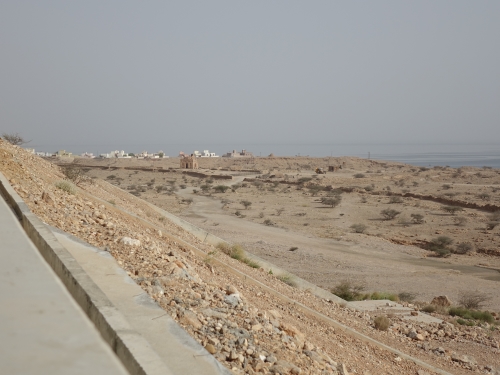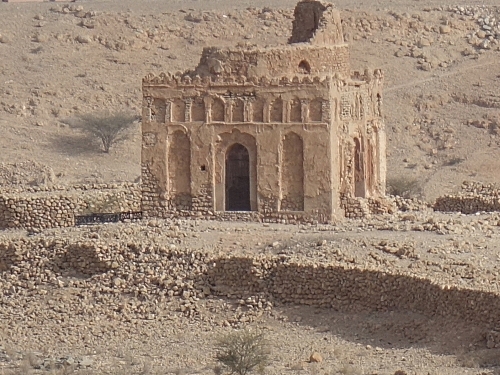Blog WHS Visits
WHS #665: Qalhat
Qalhat has been one of the surprises of 2018’s WHC session. It got inscribed, after a proposal to overturn the Referral advice by ICOMOS. I was in Oman last April and of course I was aware of the upcoming nomination. At the time though I decided to give it just a quick look, mostly because of the experiences at the site a week or two before by Martina & Ivan. They were not allowed to enter and the archaeological site seemed closed.
 After staying overnight in the not too exciting city of Sur, I left my hotel at 7.30 the next morning. I had a hike on my agenda and needed to start before the heat got too bad. But unfortunately at 7 o'clock it felt already like being in a hot air oven. My planned hike was at Wadi al-Shab, about 25 kilometers north of Sur.
On the way there you will also pass the ruins of the ancient city of Qalhat. There is a small parking space at the highway (on the direction towards Muscat from Sur) that is a good vantage point to take pictures and have a good look at its setting. The only major thing that still survives from this trading town is the Bibi Maryam mausoleum. It is easy to spot from the highway, as well as a total overview of the smallish archaeological area that is near the coast.
After staying overnight in the not too exciting city of Sur, I left my hotel at 7.30 the next morning. I had a hike on my agenda and needed to start before the heat got too bad. But unfortunately at 7 o'clock it felt already like being in a hot air oven. My planned hike was at Wadi al-Shab, about 25 kilometers north of Sur.
On the way there you will also pass the ruins of the ancient city of Qalhat. There is a small parking space at the highway (on the direction towards Muscat from Sur) that is a good vantage point to take pictures and have a good look at its setting. The only major thing that still survives from this trading town is the Bibi Maryam mausoleum. It is easy to spot from the highway, as well as a total overview of the smallish archaeological area that is near the coast.
 Qalhat is linked to the history of the Kingdom of Hormuz, a rather unknown city-state that might have been the Dubai of its era. It controlled the Strait of Hormuz from the 10th-17th century. They developed Qalhat on the opposing Omani coast as a secondary city to control both sides of the entrance to the Persian Gulf. It was mostly destroyed by an earthquake in the late 15th century and further destroyed by ransacking Portuguese in 1507.
Qalhat at the time was known to the international community as Calha. It appears under that name in the historic atlas compiled and drawn by Abraham Ortelius from 1570. Calha was visited by both Ibn Battuta and Marco Polo on their respective travels, which attest to its prominent status in the 13th -14th centuries. Ibn Battuta noted that it had "fine bazaars and one of the most beautiful mosques." This seems to relate to a larger city than the space covered by the current archaeological site.
Qalhat is linked to the history of the Kingdom of Hormuz, a rather unknown city-state that might have been the Dubai of its era. It controlled the Strait of Hormuz from the 10th-17th century. They developed Qalhat on the opposing Omani coast as a secondary city to control both sides of the entrance to the Persian Gulf. It was mostly destroyed by an earthquake in the late 15th century and further destroyed by ransacking Portuguese in 1507.
Qalhat at the time was known to the international community as Calha. It appears under that name in the historic atlas compiled and drawn by Abraham Ortelius from 1570. Calha was visited by both Ibn Battuta and Marco Polo on their respective travels, which attest to its prominent status in the 13th -14th centuries. Ibn Battuta noted that it had "fine bazaars and one of the most beautiful mosques." This seems to relate to a larger city than the space covered by the current archaeological site.
 It’s easy to become cynical about a site of an obscure civilization and where apparently so little remains. A more up and close report of someone who managed to enter the site in 2011 shows that there is indeed more to it. He noticed a crypt, a cistern and smaller domed structures. He wonders about the Bibi Maryam mausoleum, whether it was a mausoleum indeed or the long lost Great Mosque (according to a comment to his post, the Mosque has been found closer to the coastline).
I hope the Omani authorities will further excavate the site and provide it with on site information panels or a small visitor center. From what I understood from the acceptance speech of the Omani delegate at the 2018 WHC session, it will eventually reopen to the public.
It’s easy to become cynical about a site of an obscure civilization and where apparently so little remains. A more up and close report of someone who managed to enter the site in 2011 shows that there is indeed more to it. He noticed a crypt, a cistern and smaller domed structures. He wonders about the Bibi Maryam mausoleum, whether it was a mausoleum indeed or the long lost Great Mosque (according to a comment to his post, the Mosque has been found closer to the coastline).
I hope the Omani authorities will further excavate the site and provide it with on site information panels or a small visitor center. From what I understood from the acceptance speech of the Omani delegate at the 2018 WHC session, it will eventually reopen to the public.

View from the highway

Some unexplained part of the archaeological area

Bibi Mariam Mausoleum
Els - 1 July 2018